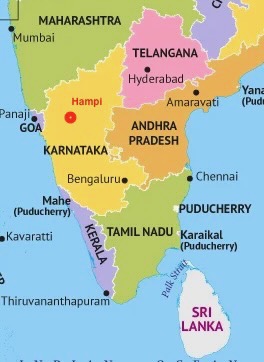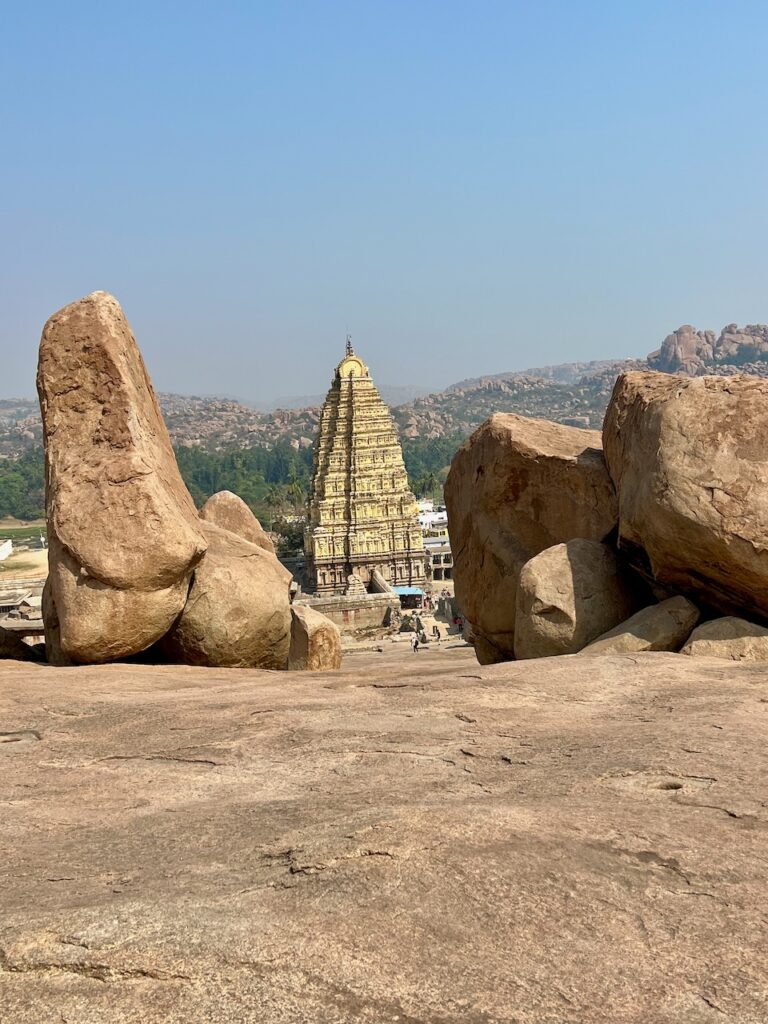
The Vijayanagara civilisation flourished between the middle of the 14th and 16th centuries. It was located in Hampi, which is in the state of Karnataka, about 300 km inland from Goa.
(In this blog, for ease of reference, I will refer more frequently to Hampi the location, than Vijayanagara the civilisation, as it does not really roll off the tongue).
During its reign, this civilisation dominated the whole of South of India. It became immensely powerful and rich over a 200 year time span. And then it fell off a cliff. A very human arc, like so many other civilisations. Born out of war with its northern Muslims neighbours (the sultanas), Hampi came to emerge thanks to a succession of strong and gifted military leaders, who gradually extended their power to forge this vast empire. But as it reached an apogee of political and military prowess, Hampi was also sowing the seeds of its own demise. Following the death of its most remarkable emperor, called Krishnadevaraya, a succession issue ensued, internal strife developed, and the empire became inward looking. Sensing weakness, its northern enemies finally succeeded in forming a coalition to topple it. A battle ensued which the Vijayanagara empire lost.
Within 6 months, the victorious Muslims had mercilessly pillaged and razed the golden empire, before withdrawing, once they realised they had no influence over the dominant Hindu population.
When you visit what is left of Hampi today, a lot of it is often restored foundations, amidst much rubble, banana and paddy fields. Just as one would see in Rome, Yucatan or Cambodia. But you quickly sense the remarkable dimensions and sophistication of what this civilisation must have been some 450 years ago. Hampi is truly an extraordinary place.
Three features struck me in particular.
- The first is the unique landscape of the place.
- The second is its religious temples and level of sophistication which continue amaze to this day.
- And last but not least, Hampi had its bazaars, built in the prolongation of the main temples, in which people came from the four corners of the world, to trade and exchange.
An unusual landscape.
As you approach Hampi, you are immediately struck by the enormous granite boulders, piled over one another, sometimes precariously, with colours varying from grey to beige and pink. A landscape from another planet. These boulders are strewn all over the area.
How did this happen?
Geologists believe that the granite plateau in Hampi was formed around 2.5 billion years ago, when the planet’s crust was being formed and continents were taking shape.
The Hampi granite is thought to have formed from the cooling and solidification of molten magma, deep beneath the Earth’s surface. As the magma cooled, it crystallised, forming the distinctive minerals and textures that are characteristic of granite. This geological formation is part of a larger one that spans parts of southern India, called the Deccan plateau.
Tectonic activity and erosion uplifted and exposed the granite to the surface. Weathering and erosion wore away the softer, more easily eroded rock layers, leaving the hard, resistant granite that now lies all over the landscape.
This unique geological history of the place has played an important role in shaping the history and culture of the Vijayanagara civilisation in Hampi.
So much for the geology.
The Hindus, however, with their fertile imagination, have a mythological explanation for the extraordinary scenery. It makes for an interesting story which you can look up by clicking here.
Temples and Musical Pillars
Hampi was known for having had hundred of temples. Five of these were major architectural complexes, characterised by their massive dimensions, cloistered enclosures, lofty towers over the entrances, and decorated pillars.
Inside their strong enclosures, they had chariot wide streets, flanked by rows of pillared mandapas (assembly and meeting rooms), which were used for festivals and processions.
Unlike our gothic cathedrals, made of towering spires, pointed arches and ribbed vaults, aimed to give a sense of distinct verticality, the Vijayanagara temples are characterised by their horizontal planes. They are built in hard granite blocks, carved with precision to fit in an interlocked and seamless fashion. And with no mortar.
These temples have absolutely exquisite ornamental features, such as carvings, sculptures, paintings, and the famous granite musical pillars. All of which reflect an unbelievable artistic and cultural achievement.
I visited the most iconic of these temples, the Vittala temple. It is famous for its stone chariot, intricate carvings and famous musical pillars.
These are so named because they produce musical sounds when struck with the thumb or a sandalwood stick. The musical effect is created by the resonance of the stone, amplified by the intricate ceilings above, which act as echo chambers. Each pillar produces a unique note. Some of them are said to mimic the sounds of animals, birds, as well as different musical instruments. It shows the incredible skill and ingenuity of the ancient Indian architects and craft workers that built and carved these pillars. To this day, and despite much scientific research, we still cannot explain how these granite pillars produce such sounds. The only thing we know for sure is there is no device inside them, which is only made of solid granite. It has to do with each pillar’s size, width, girth and disposition in each echo chamber. They continue to fascinate visitors from around the world, dumbstruck by the beautiful sound they produce.
Today the pillars no longer sing, as they have been cordoned off to preserve them. Also some of the roofs have been destroyed by the invaders.
The reason for their creation and use remains a mystery. They continue to keep hidden their fascinating secret.
The video below will give you a glimpse of how these musical pillars sound.
Hampi Bazzars
In the prolongation of each major temple in Hampi, there were very dynamic and busing trade bazaars. The stores were housed in single story colonnaded stone buildings, bordering a large avenue on either side, and up to 1km long in length. Today only a few have survived survive ….
There were at least 5 of these bazaar centres, each specialised in certain types of goods and produce.
A few travellers who visited Hampi in those days, have left a written chronicle behind, to describe the fabulous riches that could be seen and bought in these bustling bazaars.
Hampi is located on the banks of the Tungabhadra River, which provided a convenient means of transportation for all sorts of goods. It was also at the center of several important trade routes, including the Silk Road, which connected India with China, the Middle East, and Europe. All this contributed to making Hampi an ideal location for merchants and traders.
Such was the frenzied activity in Hampi that historians speculate that up to 500,000 people might have lived or were transiting at certain points in time in this alibabaesque city.
The primary goods traded in Hampi included:
- Cotton and textiles: Hampi was famous for its cotton textiles, which were exported to various parts of India and overseas. The city had many weavers who produced high-quality fabrics using locally grown cotton.
- Spices: Hampi was a major center for the trade of spices such as pepper, cardamom, and cloves. These spices were in high demand in Europe and the Middle East and were exported through the ports of Goa and Calicut.
- Rice: The fertile lands around Hampi produced high yields of rice, which was a staple food for the people of South India. The surplus rice was traded with other regions of India and also exported to Southeast Asia.
- Precious stones and metals: Hampi was renowned for its nearby diamond and other precious stone mines, which produced some of the finest diamonds in the world. Gold, silver, and rubies were also traded in the city.
- Horses: The Vijayanagara Empire was known for its cavalry, and they imported all their horses from Arabia and Persia, to maintain the army. Horses for some reason do not breed well in tropical lands, and were a high value feature in Hampi.
It is worth reproducing excerpts of Domingo Paes’ chronicle, a Portuguese traveller who visited the Vijayanagara Empire in around 1520. He wrote:
“Going forward, you have a broad and beautiful street, full of rows of fine houses, and it is to be understood that these houses belong to men rich enough to afford them.
In this street live many merchants, and there you will find all sorts of rubies, and diamonds, and emeralds, and pearls, and seed-pearls, and cloths, and every other sort of thing there is on earth and that you may wish to buy. Then you have there every evening a fair where they sell many horses and nags, and also many citrons, and limes, and oranges and grapes, and every other kind of garden stuff, and wood; you have all this in the street.
(…)
The people in this city are countless in number, so much so that I do not wish to count it down for fear that it should be thought fabulous, but I declare that no troops, horses or foot, could break their way through any street or lane, so great are the numbers of people and elephants.
This is the best provided city in the world, and is stocked with provisions such as rice, wheat, grains, Indian-corn, and a certain amount of barley and beans, grams, pulses, horse-gram, and many other seeds which grow in this country which are the food of the people, and there is a large store of these and very cheap. The streets and markets are full of laden oxen without count, so that you cannot get along for them. There is much poultry. in this country there are many partridges. And of these, you will find the markets full; as also of quails, and hares, and of all kinds of wild fowl. All these birds and game animals they sell alive.
Then the sheep that they kill every day are countless, one could not number them, for in every street there are men who will sell you mutton. Then to see the many loads of limes that come each day, and also loads of sweet and sour oranges, and wild brinjals (egg plant), and other garden stuff in such abundance as to stupefy one. “
Such chronicles evoke the Tales of a Thousand and One Nights, such was the fabulous wealth and vibrancy of Hampi in those days. And all this was both of top quality and incredibly cheap.
A powerful magnet to attract people from very far away. There were people from all over the world, and an amazing range of language were spoken on the streets on the streets of Hampi. An extraordinary place of exchange, not just of goods but also of knowledge, culture and custom.
Looking back, the fantastical landscape and remaining ruins make Hampi a fascinating place. A once powerful civilisation animated this place, and though it only existed for some 200 years, or less than 10 generations, its sophistication, vision and bustling economy still leaves a powerful impression on the traveller’s mind. Hampi is a must see place, just like Knossos, the valley of the Nile, or Angkor Wat.

